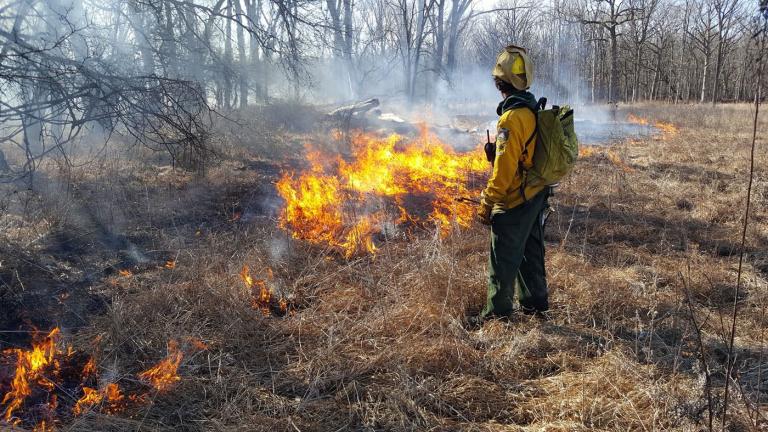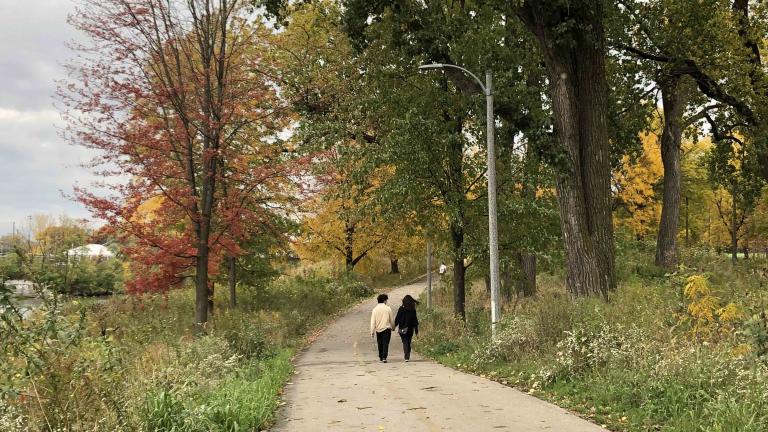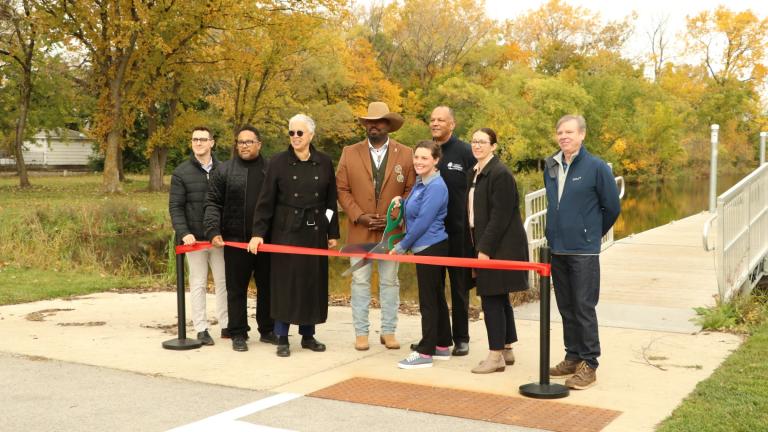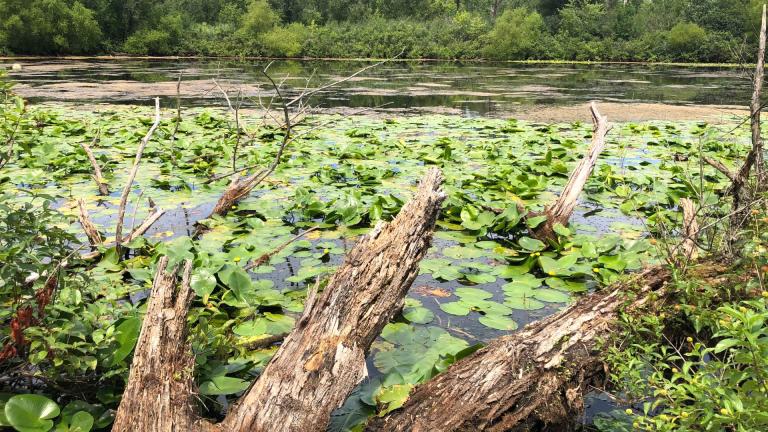Right now, the Red Gate Woods area of the Palos Preserves system in southwestern Cook County looks like a disaster zone.
The ground is littered with tree stumps and branches, the kind of destruction a tornado might wreak or that a logging company might leave in its clear-cutting wake.
In fact, the devastation is evidence of the opposite: The landscape is being brought back to life.
Over the next few years, the Forest Preserve District of Cook County will spend $10 million to improve more than 1,000 acres of habitat in this section of the Palos system.
“This is our biggest restoration project ever, ever, ever,” said Eileen Figel, interim general superintendent of the district.
Video: The landscape looks different after brush is cleared from the Red Gate Woods in the Cook County Forest Preserve’s Palos system. (Patty Wetli / WTTW News)
All the debris, it turns out, is the result of the first step in the restoration process — getting rid of the invasive honeysuckle shrub that’s been choking the native forest and wetlands.
So far, contractors have laid waste to some 200 acres of honeysuckle, according to Troy Showerman, resource project manager for the forest preserve district.
It’s just a fraction of the project’s ultimate goal, but the crews’ progress has already opened up views of Red Gate’s spectacular features that the invasive shrub had shrouded, including ravines seldom found in the region.
“Before the project, you would be in a tunnel of invasive brush — a solid wall of honeysuckle,” said Becky Collings, senior resource ecologist with the forest preserve district.
All that green may have created the illusion of a thriving ecosystem but in truth, the thickets of honeysuckle stunted the growth of native plants and wildlife. Spring ephemerals — the first bloomers on the forest floor — weren’t able to thrive under honeysuckle’s dominance, for example, and that had a cascading effect on the food chain, starting with insects not being able to find the nectar they needed.
The glut of honeysuckle also contributed to soil erosion and compaction, which decreased stormwater retention. And for visitors to the preserves, the dense greenery led to safety concerns, both real and perceived. Cyclists using the system’s trails frequently encountered blind curves and the hiking experience was borderline claustrophobic.
“I think people really feel better in the woods, they feel safer, when they can see what’s coming. It’s just better to have sightlines,” said Chris Slattery, planning and development manager for the preserves.
 A map of the Palos system. Restoration is taking place in the vast area west of Wolf Road. A second phase could tackle the rest. (Patty Wetli / WTTW News)
A map of the Palos system. Restoration is taking place in the vast area west of Wolf Road. A second phase could tackle the rest. (Patty Wetli / WTTW News)
To understand how big of a swing this project is for the forest preserves, consider that of the district’s 77,000 acres, roughly 15,000 are under active management. In a typical year, the district and its various partners clear an average of 700 to 1,000 acres across the county — work that’s limited to winter months in order to minimize the impact on wildlife and soil.
“Basically we’re cramming everything we do in the county in one winter to this project,” Showerman said. “So the scale of this is massive for us, and very exciting.”
It’s even more ambitious given that the district only began ramping up its restoration efforts within the past decade.
Where the focus was once on simply preserving land from development, there’s now an understanding that natural areas require active and ongoing maintenance to preserve high-quality habitat, Collings said.
A Natural and Cultural Resources Master Plan released in 2015 — developed with guidance from the Prairie Research Institute at the University of Illinois — laid out a blueprint for the district in terms of prioritizing restoration, and the Palos system topped that list.
At 12,000 acres, the Palos region represents the second largest concentration of protected natural areas in the region, topped only by Midewin National Tallgrass Prairie.
But of Midewin’s 22,000 acres, just 200 are considered “remnant,” meaning lightly used, with intact plant communities, Collings said. Palos, on the other hand, is largely remnant.
“So arguably we’re maybe standing in the most important natural area in our region,” she said during a recent tour of Red Gate.
 A more open forest allows native plants like mayapple to thrive in the understory. (Patty Wetli / WTTW News)
A more open forest allows native plants like mayapple to thrive in the understory. (Patty Wetli / WTTW News)
Preserves in the Palos system were pieced together between 1918 and 1942, but the history of the land goes back some 15,000 years.
The area surrounding Red Gate Woods is what remains of a glacial land form called Mount Forest Island, an elevated triangle surrounded by ancient glacial waterways, Collings explained.
As a result of that glacial history, visitors will find a rolling topography that’s rare in Illinois — a significant reason the area wasn’t farmed — along with a diversity of landscapes. The uplands feature oak woodlands and oak savannas, while wetlands formed in glacial depressions, providing crucial habitat for salamanders, snakes and amphibians.
Ravine slopes, which drain water north to the Des Plaines River and south to Saganashkee Slough, create their own micro-climates, supporting plant communities that prefer moister, cooler conditions, including hardy native gooseberry shrubs that have survived the honeysuckle invasion. Forest preserve staff meticulously identified and tagged some 4,000 native shrubs to protect during the restoration.
“It’s a really unique part of the forest preserve system where, because of the size of this and the different land use history here, I like to tell people that if you look hard enough you can find anything at Red Gate Woods,” Showerman said.
 The restoration project at Red Gate Woods also includes funds to upgrade trail signage, which currently is confusing. (Patty Wetli / WTTW News)
The restoration project at Red Gate Woods also includes funds to upgrade trail signage, which currently is confusing. (Patty Wetli / WTTW News)
Of the $10 million being spent at Red Gate Woods — state funds received via a Build Illinois grant — half is designated for resource management and half to planning and development.
Because as important as Palos is to plants and animals, it’s also a vital resource for humans.
With two nature centers, a campground, canoe and kayak rentals, and three fishing lakes, plus the wildly popular Swallow Cliff Stairs, the system has become an outdoor recreation destination, Slattery said.
“It’s kind of similar in size to some of the smaller national parks,” she said. “The Indiana Dunes is approximately 15,000 acres, so this getting into that range.”
But of the Palos system’s 78 miles of trails — accounting for nearly one-quarter of the entire forest preserve district’s network — 65 are unpaved and suffering from erosion, with trail crews identifying 60 severe trouble spots.
The state funds will be used to improve trail conditions and also to address the “wayfinding” problem. As in, the trail system is so convoluted, it’s easy to get lost. There are nearly 20 different trail options, and at some points three or four may intersect, with minimal information to guide hikers or cyclists in the right direction.
People set out on a trail and don’t know how long it’s going to take to get back, or what their destination might be, like a pond or picnic shelter, Slattery said. “So there’s a need for more signage. We need to improve our trailheads and put more maps and more wayfinding signs.”
Video: With the removal of invasive shrubs, visitors can actually see the wetlands at Red Gate Woods in the Cook County Forest Preserve’s Palos System. (Patty Wetli / WTTW News)
With restoration barely underway at Red Gate Woods, Showerman is already thinking of a second phase, which would extend the clearing of honeysuckle into an adjacent 600 acres. It’s a race against climate change, he noted, with a shrinking window of opportunity.
Restored landscapes are more resilient in general but especially so when it comes to handling more intense storms and precipitation, particularly in terms of allowing more water to infiltrate into the ground, he said. And that in turn will benefit native plants and animals, which he expects will experience added environmental stressors.
But the timeframe for restoration work on the scale being attempted at Red Gate is highly dependent on old-fashioned Midwestern winters, with temperatures cold enough to freeze the ground and allow crews to bring in heavy equipment.
“The concern everyone has is rain in the winter,” Showerman said.
Chicago notably experienced the warmest February on record this year and it’s impossible to predict what next winter will bring. While the uncertainty adds an extra degree of difficult to the already complicated process of eco-restoration, the forest preserve district is committed to returning as much of Palos to its natural state as possible.
“All these plants, all these animals, if we did nothing, we would lose them,” Showerman said. “I think (restoration work) is our responsibility, in the name of biodiversity.”
Site A, Los Alamos of the North
 A marker at Site M, the location of one of two buried nuclear reactors at Red Gate Woods. (Patty Wetli / WTTW News)
A marker at Site M, the location of one of two buried nuclear reactors at Red Gate Woods. (Patty Wetli / WTTW News)
Red Gate Woods is home to some of the region’s most impressive natural resources, and arguably its strangest cultural resource.
A mini-Los Alamos research center was built here during World War II as part of the nation’s development of the nuclear bomb. Following the war, this research operation relocated a few miles north — that's the origin of Argonne National Laboratory — but they left their nuclear reactors behind.
Yep, the government buried the reactors in the forest preserve. Two sizable stone slabs mark the locations — dubbed “Site A” and “Plot M” — one etched with the helpful note: “Caution: Do not dig.”
Low-level radioactive soil was still being removed from the site into the 1990s, but as of 2002, the Illinois Department of Public Health concluded there was no longer any risk to the public.
The sites remain actively monitored for contaminants.
For a deeper dive into Red Gate Woods nuclear past, check out the forest preserve's fairly comprehensive history online. WTTW’s own Geoffrey Baer also recently delved into subject as part of his “Chicago Mysteries“ show.
Contact Patty Wetli: @pattywetli | (773) 509-5623 | [email protected]








